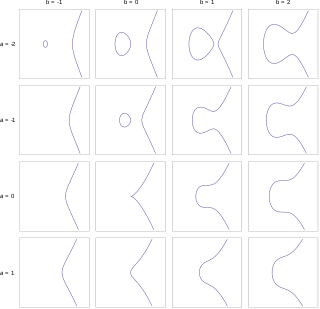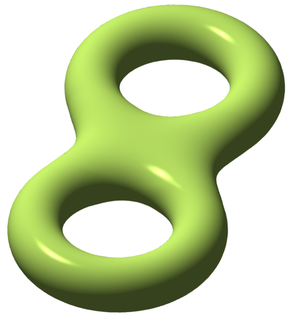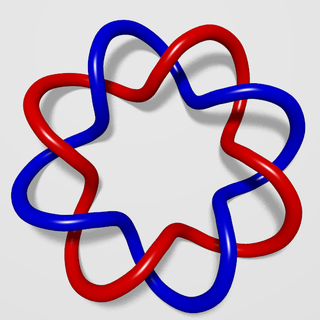In the mathematical field of low-dimensional topology, the slam-dunk is a particular modification of a given surgery diagram in the 3-sphere for a 3-manifold. The name, but not the move, is due to Tim Cochran. Let K be a component of the link in the diagram and J be a component that circles K as a meridian. Suppose K has integer coefficient n and J has coefficient a rational number r. Then we can obtain a new diagram by deleting J and changing the coefficient of K to n-1/r. This is the slam-dunk.

Mathematics includes the study of such topics as quantity, structure, space, and change.

In mathematics, low-dimensional topology is the branch of topology that studies manifolds, or more generally topological spaces, of four or fewer dimensions. Representative topics are the structure theory of 3-manifolds and 4-manifolds, knot theory, and braid groups. It can be regarded as a part of geometric topology. It may also be used to refer to the study of topological spaces of dimension 1, though this is more typically considered part of continuum theory.
In topology, a branch of mathematics, a Dehn surgery, named after Max Dehn, is a construction used to modify 3-manifolds. The process takes as input a 3-manifold together with a link. It is often conceptualized as two steps: drilling then filling.
The name of the move is suggested by the proof that these diagrams give the same 3-manifold. First, do the surgery on K, replacing a tubular neighborhood of K by another solid torus T according to the surgery coefficient n. Since J is a meridian, it can be pushed, or "slam dunked", into T. Since n is an integer, J intersects the meridian of T once, and so J must be isotopic to a longitude of T. Thus when we now do surgery on J, we can think of it as replacing T by another solid torus. This replacement, as shown by a simple calculation, is given by coefficient n - 1/r.

In mathematics, a tubular neighborhood of a submanifold of a smooth manifold is an open set around it resembling the normal bundle.

In mathematics, a solid torus is the topological space formed by sweeping a disk around a circle. It is homeomorphic to the Cartesian product of the disk and the circle, endowed with the product topology. A standard way to visualize a solid torus is as a toroid, embedded in 3-space. However, it should be distinguished from a torus, which has the same visual appearance: the torus is the two-dimensional space on the boundary of a toroid, while the solid torus includes also the compact interior space enclosed by the torus.

A slam dunk, also simply dunk, is a type of basketball shot that is performed when a player jumps in the air, controls the ball above the horizontal plane of the rim, and scores by putting the ball directly through the basket with one or both hands. It is considered a type of field goal; if successful, it is worth two points. Such a shot was known as a "dunk shot" until the term "slam dunk" was coined by former Los Angeles Lakers announcer Chick Hearn.
The inverse of the slam-dunk can be used to change any rational surgery diagram into an integer one, i.e. a surgery diagram on a framed link.








